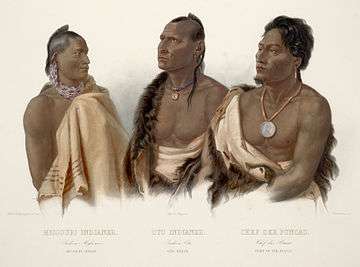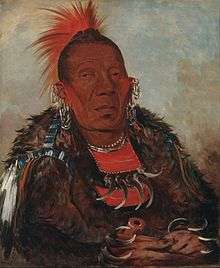Otoe–Missouria Tribe of Indians
The Otoe–Missouria Tribe of Indians is a single, federally recognized tribe, located in Oklahoma. The tribe is made up of Otoe and Missouria Indians. Traditionally they spoke the Chiwere language, part of the Siouan language family.
 official Otoe–Missouria tribal seal | |
| Total population | |
|---|---|
| 3,049[1] | |
| Regions with significant populations | |
| Languages | |
| Chiwere language, English | |
| Religion | |
| traditional tribal religion, Native American Church, Christianity | |
| Related ethnic groups | |
| Otoe, Missouria, Ho-Chunk, Iowa, and other Siouan peoples |
History
The Otoe, or Oto, and Missouria, or Missouri, tribes both originated in the Great Lakes region. They are thought, along with the Ho-Chunk and Iowa tribes, to have once been a single tribe. In the 16th century, the Iowa, Otoe, and Missouria broke away from that tribe and moved to the south and west. By the late 17th century, the Missouria had settled near the Missouri and Grand Rivers in Missouri.[2]
Meanwhile, the Otoes settled along what is now the Iowa-Minnesota border. They first came into contact with Europeans in late 17th century.[2] Jacques Marquette, the French explorer, included them in a 1673 map, placing the Otoe near the Des Moines and upper Iowa Rivers. Pierre Le Moyne d'Iberville wrote in 1700 that the Otoe and the Iowa lived with the Omaha tribe, between the Mississippi and Missouri Rivers.[3] After contact, they migrated to Nebraska and settled near the Platte River on what became the Otoe Reservation.[2]
The 18th century was devastating for the Missouria people. Smallpox killed many in the tribe, as did constant warfare with enemies, such as the Sac and Fox. In 1796, some surviving Missouria joined the Osage and Kaw tribes, while 80 Missouria joined the Otoe.[2]
In the 19th century, the Missouria and the Otoe established permanent villages consisting primarily of earth lodges, but also occasionally tipis and bark lodges. Their joined society was patrilineal and comprised seven to ten clans. Tribal members had to marry outside of their clan. Each clan had a leader, and together the clan chiefs formed a tribal council. The chief of the Bear Clan was the principal leader of the tribes. They hunted buffalo and grew such crops as squash, beans, corn, and pumpkins.[2] In 1803, Lewis and Clark estimated their population to be 500. George Catlin estimated their population at 1200 in 1833. In 1830 there were an estimated 1500 Otoe–Missouria living in together. By 1886, only 334 Otoe–Missouria survived.[3]
The first land cession treaty between the Otoe–Missouria and the United States was in 1830. These were followed by more treaties in 1833, 1836, and 1854. The 1854 Treaty established a reservation on the Kansas-Nebraska border, near the Big Blue River. The tribe split in factions of assimilationists and traditionalists. The assimilationist Otoe–Missouria were influenced by Quaker missionaries and became known as the Quaker Band. The traditionalists were known as the Coyote Band.[2]
In 1876 Congress arranged the sale of 120,000 acres (490 km2) of the Otoe–Missouria reservation and sold the rest in 1881, when Congress forced the Otoe–Missouria into Indian Territory. The Coyote Band settled on the Sac and Fox reservation, while the Quaker Band settled on their own small, 113-acre (0.46 km2) reservation in present-day Noble and Pawnee Counties.[2]
The Coyote Band rejoined the Quaker Band, but their reservation was almost immediately broken up into individual allotments, as dictated by the Dawes Act, in the 1890s. A total of 514 Otoe–Missourias received individual allotments. Much later, in the 1960s the Otoe–Missouria people were compensated for their lands lost during the 19th century by the Indian Claims Commission.[2]
The tribe's constitution was ratified in 1984 in accordance with the Oklahoma Indian Welfare Act.[2]
 Missouria Indian, Otoe Indian, and Chief of the Poncas, by Karl Bodmer
Missouria Indian, Otoe Indian, and Chief of the Poncas, by Karl Bodmer Painting of Wah-ro-née-sah (The Surrounder), Otoe chief, painted by George Catlin, 1832
Painting of Wah-ro-née-sah (The Surrounder), Otoe chief, painted by George Catlin, 1832 Otoe–Missouria men's moccasins, ca. 1880, Oklahoma, Oklahoma History Center
Otoe–Missouria men's moccasins, ca. 1880, Oklahoma, Oklahoma History Center
Government
The Otoe–Missouria Tribe of Indians is headquartered in Red Rock, Oklahoma, and their tribal jurisdictional area is in Noble County and Kay County, Oklahoma. There are 3,089 enrolled tribal members with the majority living within the state of Oklahoma.
The Tribal Council is the elected governing body of the Otoe–Missouria Tribe. The primary duties of the Tribal Council are to enforce the Tribal Laws and Policies and to serve as the decision-making authority on budgets and investments. The Tribal Council is also the parent body for the Tribal Administration. Overall, the Tribal Administration ensures that services, as decided by the Tribal Council, are provided to Tribal Members.
The Tribal Council consists of a seven members elected by secret ballot by qualified voters of the Tribe. The terms for each member are staggered and last for three years. There are no term limits. Each Tribal Council member has responsibilities for certain duties as listed in the Otoe–Missouria Tribe of Indians Constitution.
The Council holds regular meetings monthly in a place and date determined by the members. Currently the meetings are held in the Council Building at tribal headquarters. And are open to the public, except when the Council is in Executive Session.[4]
The tribe's Chairman is John R. Shotton, currently serving a three-year term.[1] Shotton has the distinction of being the youngest person to ever serve on the tribal council, being first elected when he was 29 years old.[5]
Economic development
The tribe operates its own housing authority and issues tribal vehicle tags. They own two gas stations, two smoke shops, two financial services companies, and five casinos. The estimated annual economic impact of the Otoe–Missouria Tribe is $156.30 million.[6] The Otoe–Missouria casinos are 7 Clans Paradise Casino in Red Rock; First Council Casino in Newkirk, and Lil' Bit of Paradise Casino—Chilocco, also in Newkirk; and Lil' Bit of Paradise Casino—Red Rock, in Red Rock. A new casino was opened in May 2016 in Perry, Oklahoma.[7]
In October 2016, through a deal reached with Macfarlane Group CEO Mark E. Curry, the Tribe acquired technology vendor MacFarlane Group. MacFarlane Group previously assisted the Tribe with underwriting and call center support for American Web Loan, one of the Tribe's financial services companies.[8]
On May 20, 2019, the NCUA presented a federal credit union charter to the Otoe-Missouria Federal Credit Union in Red Rock, Oklahoma. The Otoe-Missouria Federal Credit Union will serve approximately 4,200 members and employees of the Otoe-Missouria Tribe.[9]
A study completed by the Taylor Policy Group concluded that the Tribe's efforts to diversify its economy resulted in a massive economic impact to Oklahoma and surrounding areas, including over $45 million in direct compensation to employees across the Tribe's various enterprises.[10]
Language and culture
At most three tribal members still speak the Otoe or Chiwere language;[11] however, the tribe has a program to revitalize the language. Language classes are held weekly in Edmond, Oklahoma.[12]
For well over a century, since 1881, an annual Otoe–Missouria Encampment is held every third weekend in July near Red Rock, Oklahoma.
Notable Otoe–Missouria people
- Annette Arkeketa, author
- Anna Lee Walters (b. 1946), author and publisher
- Truman Washington Dailey (1898–1996), fluent language speaker, traditionalist
See also
Notes
- "Oklahoma Indian Tribe Education Guide" (PDF). Oklahoma State Department of Education. 2014. Retrieved 2 Oct 2014.
- May, Jon D. (2009). "Otoe–Missouria". Encyclopedia of Oklahoma History & Culture. Oklahoma Historical Society. Archived from the original on 2010-07-20. Retrieved 22 Feb 2009.
- Oto Indian Tribe History. Access Genealogy: Indian Tribal Records. (retrieved 22 Feb 2009)
- Website of Otoe–Missouria Tribe of Indians http://www.omtribe.org/index.php?government
- "John Shotton Elected Youngest Member Ever to Otoe–Missouria Tribal Council." Archived 2010-07-25 at the Wayback Machine The University of Oklahoma Outreach: Public & Community Services. July 2006 (retrieved 22 Feb 2009)
- Taylor, Jonathan. "Economic Impact of the Otoe-Missouria Tribe of Oklahoma" (PDF). omtribe.org. Taylor Policy Group. Retrieved 27 January 2020.
- "Tribal Enterprises". The Otoe–Missouria Tribe. (retrieved 19 May 2011)
- "MacFarlane Group Purchase Will Augment Tribe's E-commerce, Lending Capabilities Group". Tribal Business Journal.
- Hood, Rodney (2019-05-20). "NCUA Charters Otoe-Missouria Federal Credit Union" (Press release). NCUA. Retrieved 2019-05-22.
- "Impact Study Highlights Otoe-Missouria as Rising Economic Powerhouse in Oklahoma". Native Business Magazine. 4 November 2019. Retrieved 24 January 2020.
- Anderton, Alice, PhD. (2009). "Status of Indian Languages in Oklahoma". Intertribal Wordpath Society. Archived from the original on 17 September 2010. Retrieved 22 Feb 2009.CS1 maint: multiple names: authors list (link)
- "Otoe Language Program". The Otoe–Missouria Tribe. Retrieved 24 Jan 2012.
External links
| Wikimedia Commons has media related to Otoe. |
- Website of the Otoe–Missouria Tribe of Indians
- Constitution of the Otoe–Missouria Tribe of Indians
- Otoe–Missouria, Oklahoma Historical Society's Encyclopedia of Oklahoma History and Culture